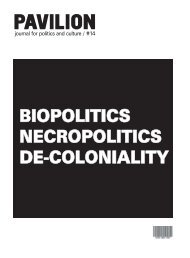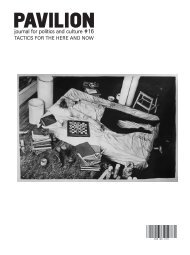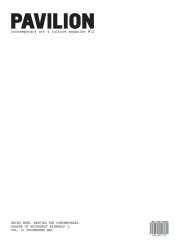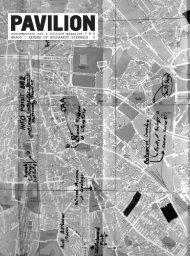PAVILION
PAVILION
PAVILION
- No tags were found...
Create successful ePaper yourself
Turn your PDF publications into a flip-book with our unique Google optimized e-Paper software.
the self. Architecture thus not only consists<br />
of demolishing and triumphal erection,<br />
calculation and construction, but<br />
also of incuring, inserting oneself, withdrawing<br />
and enduring. It is not only comprised<br />
of a representation of an imperative<br />
will, but also of transformations, fluidity<br />
and movement, conversion and transference.<br />
If one wants to get beyond architecture’s<br />
planning ideology, a notion of action is<br />
required, that does not rely on cognitions,<br />
making of plans and a subject’s assertion<br />
as criteria for successful completion, but<br />
instead asks the question of how and<br />
whereupon a world is brought into being<br />
and altered. Architecture is not simply a<br />
question of skill.<br />
The search for the fundamentals of<br />
action should thus be aimed at performativity<br />
as the potential of a process (of execution)<br />
to generate reality and form cultures.<br />
Such a process comes into being<br />
in a situation in which an action might<br />
suggest itself but is not enforced.<br />
Performativity depends on open situations.<br />
The unity of an action might be perceived<br />
as a catastrophe, an accident, an<br />
event or an incident, as a great deed or<br />
silly coincidence. However, it does not<br />
exhaust itself in the perception, which<br />
shapes it, nor in the movement, which<br />
causes it or which it responds to. Action is<br />
a process, a transformation, a change, a<br />
flow, a frantic standstill, always simultaneously<br />
characterised by rest and modification,<br />
which means, by the tension that<br />
distinguishes a situation from a condition.<br />
In a condition there is no space for<br />
actions, no change of structures, no room<br />
for unforeseen developments, steps,<br />
thresholds, transitions, as they are representative<br />
for situations. Situations enable<br />
actors to do something. These opportunities<br />
rest and remain unclaimed until<br />
those capable of doing so, seize them.<br />
The possibility of acting, the enduring<br />
and one’s conduct arise from a situation.<br />
This tension inherent in an open situation<br />
not only evokes the human subject of<br />
action. Rather the performative characteristics<br />
of forces, things and creatures<br />
count equally. That the material base formats<br />
situations is revealed particularly in<br />
the architecture of the public space. On<br />
the one side this architecture has to be<br />
aimed at eliciting actions from forces,<br />
things or creatures and becoming the<br />
interface of interactions. Thereto it has to<br />
make its openness visible, so that persons,<br />
things or forces can appear and<br />
show themselves in a manner not predetermined.<br />
On the other hand it has to<br />
organise the perception of these actions<br />
in such a way that these mark reality. The<br />
architecture of public spaces thus has to<br />
open up an arena, it has to arrange perception<br />
as the level of expectations into<br />
which an act enters and which it nonetheless<br />
at the same time surprises. Actions<br />
differ precisely from activities in that they<br />
are neither expectable nor compliant to<br />
certain rules.<br />
This organisation can not, as those referring<br />
to modern phenomenology or philosophical<br />
anthropology believe, be<br />
achieved by the body or the plaiting of<br />
participation and distance in the intermediate<br />
corporeality: Their execution<br />
processes of perceptions are already<br />
based on the contingent preconditions of<br />
a situation, which first of all has to permit,<br />
grant and even evoke execution processes<br />
of action and thus activity and passiv-<br />
ity, action and reaction. What senses and<br />
patterns of activation we develop is a biological<br />
answer towards the properties of<br />
the world, which we inhabit. This biological<br />
answer, this cultivation of organs thus<br />
depends on free areas, which can be<br />
used as resources of transformation. In<br />
this sense architecture should be understood<br />
as the creation and configuration of<br />
sensuality.<br />
At the centre of the public space is thus<br />
an action, in the sense that architecture<br />
first allows the thing, force or creature a<br />
leeway to act differently or even not at all.<br />
Accordingly, architecture is not a structural<br />
parameter, but that which lets an action<br />
appear - by no means exclusively as<br />
building - but, by way of example, as the<br />
actors assembling themselves and relating<br />
to each other. It is reciprocally modified<br />
by each action. Designing, building,<br />
using and changing public space are<br />
equally ways of acting. Actions respond<br />
to each other and thereby change the<br />
interstices in which they happen. The<br />
architecture of this zone thus forms an<br />
event out of that which comes into being<br />
in such a performative situation.<br />
The first consequence of an analysis of<br />
performativity from the perspective of<br />
architecture is that actions depend on a<br />
situational framework of conditions.<br />
These facilitate differentiation between<br />
operations, incidents and execution<br />
processes. This framework of conditions<br />
determines the modalities of such differentiations<br />
through embodiment. Secondly,<br />
it follows that these distinctions<br />
correspond to specific patterns of interactions.<br />
These patterns crystallize from the<br />
embodiments and determine who can act<br />
and what counts as an action. Thirdly,<br />
from this notion of action - having in view<br />
the happening - follows the assumption<br />
that a situational anticipation is needed if<br />
the unforeseen should materialise in an<br />
observable way.<br />
The possibility of acting intentionally is<br />
merely a derivative of performative architecture.<br />
From this challenge of the notion<br />
of planning follows the idea that places -<br />
depending on the degree to which they<br />
were planned by an individual - have<br />
hardly any chance to appear as public<br />
spaces. The action in the sense of implementing<br />
the plan is the attempt to force<br />
purpose, functions, structures of meaning<br />
onto reality, with the result that the situationally<br />
generated reality merely counts<br />
as auxiliary criterion to the aims of an<br />
individual or a society. Performativity of<br />
the architect has not for nothing been the<br />
paradigm of the demiurge, the creator<br />
god, up until Leibniz; but at the same time<br />
it is also the model of a political dictatorship,<br />
in which only one will counts.<br />
In his “Physics” Aristotle describes architectonics<br />
as the art of working with a<br />
material to fabricate a purposeful object.<br />
Someone who uses this object has to be<br />
familiar with its form. However, the producer<br />
of this object, as the architect, has<br />
to know the qualities of the material in<br />
view of a particular function. Accordingly,<br />
the architect is not the one who actually<br />
fabricates the product or uses it, but the<br />
one who develops the form-content unity<br />
of a product by projecting its matter of<br />
existence before it is even there.<br />
However, designing is but only one version<br />
of architecture.<br />
A particular structure of social relations,<br />
an artificial, common world is the prereq-<br />
[174]<br />
[175]








